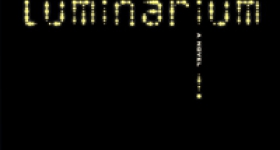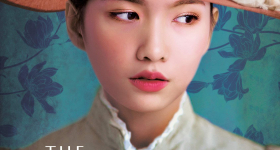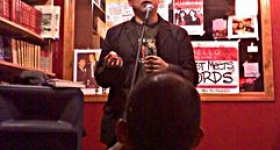Fifteen-year-old Tina Malhotra's life is thrown for a loop when her best friend since kindergarten, Alex, deserts her and
starts hanging out with the popular kids. Alone but defiant, Tina chooses to
spend her time on her existentialist diary -- a project created by her teacher
for his English class. Spouting wisdom straight from Jean Paul Sartre's books,
Tina attempts to navigate high school and life using Sartre as inspiration,
mentor, and friend. Although Tina is certain that she is not like any of
the other teenagers in her school, the existentialist project does spur her on
a journey of self discovery. Interestingly, this self-discovery revolves around
the one obsession that she does share with all the other teenage girls in her
school: the hallowed, mysterious and magical first kiss. Or, in Tina's case,
the lack of one.
Tina's Mouth is written by Keshni Kashyap and illustrated by Mari Araki. The book
is aimed at a young adult audience. Born and raised in L.A. by Indian parents, Kashyap is a screenwriter and
director whose student films Hole and Good Thing won her UCLA
Spotlight Awards. Originally from Japan, Mari Araki is a surrealist painter and
digital artist who now resides in Southern California. While Tina's Mouth
is Kashyap's first book, Araki has previously written and illustrated the
decidedly adult Five Dicks the Charm.
Tina’s
Mouth is dominated by text, often featuring
prose-style sections as Tina writes in her journal. Since Tina's Mouth is the diary of a
teenager, the art is aptly amateur and unpolished, which lends authenticity. However, Araki does manage to weave some surrealism into
the panels. This is most obvious in a splash page where Tina asks, “What is
nirvana, mon philosophe?” Her question is accompanied by a two-page spread of
paisley patterns, flowers, butterflies and hearts at the center of which is
Tina's mouth shooting out a rocket. The visual is representative of Tina's
inner feelings; she's all butterflies and hearts as she prepares for that
exquisite experience of her first kiss.

The artwork in Tina's Mouth is
rendered in black, grey and white, with grey being the dominant shade. However,
pairing huge swaths of grey with the white background of the page itself makes
the artwork less arresting than it could have been. One of the other problems
with the art in the book is not the artist's fault. On the splash pages,
Araki's work is swallowed up in the middle by the binding, making some words
unreadable and often throwing off the symmetry of the piece.
Tina's Mouth also veers away from traditional graphic novel format in that the
book is not divided into panels uniformly. Panels often appear on the page next
to huge chunks of text but often, there are no bordered panels at all. In this
sense, Araki is extremely creative in her organization of text and art, and it
is never difficult to follow the story despite the lack of conventional borders
to divide one panel from another.
In the immediate aftermath of Alex's
withdrawal from her, Tina finds herself in the unenviable position of having
to start over in high school. The pressure does not destroy her sense
of humor, however. She wryly notes one evening, while accompanying her parents to an
Indian party that, “1. There is no point to anything. 2. Because death is final
and random. 3. And existentialism is brilliant.” As soon as this realization
hits her, she informs her parents that she is “not making my bed anymore. There
is no point to it.”
Alex may have been Tina's first heartbreak
but her story really begins when she falls in love with Neil Strumminger, a
skateboarder. He's the one she wants to kiss. Mixing her newfound
existentialism with her Hindu upbringing, Tina dreamily wonders, “Who knows why
people fall in love. They just do. Maybe he looks like somebody from a past
life that I was in love with.” Enchanting as Neil is, Tina learns about love,
heart-break and angst in her brief and often confusing relationship with him.

Tina's narrative often goes beyond herself
to include her parents, her sister Anjali, her brother Rahul and the larger
South Asian community. The result is a portrait of an
Indian family that thankfully breaks all stereotypes. As Tina herself notes,
her parents “have never tried to lock me into a child marriage, nor have they
pushed me into spelling competitions.” Instead, Tina's mother is something of
an atheist, her sister is an artist and their world is anything but
conservative. Of course, that doesn't mean that they are devoid of their
cultural flavors. The Malhotras attend lavish parties thrown by their Indian
friends, argue about the amount of ghee in the daal, and misguidedly try to set
up Anjali with a suitable match when she returns from New York depressed over a
failed relationship.
Sassy and funny with a wry sense of humor, Tina is an easy protagonist to relate
to. With her easy wit and
astute observations on life, which often
make her seem more mature than her age, Tina resembles the title character from the
2007 film Juno, but without the teenage pregnancy bit. Every South Asian
in America will identify when she notes that there are two
questions people ask her when they find out that she's Indian: “What's a good
Indian restaurant” and “What does the dot mean?” In the page that follows, more
stereotypical questions spiral toward her as Tina stands in the center, her
middle finger raised in a defiant gesture.
All in all, Tina's Mouth is a
humorous and philosophical coming-of-age story that will appeal more to teenagers
than adults. Kashyap captures the high school universe and articulates teenage
angst with a finesse and dry wit that will charm fans of Catcher in the Rye and
Juno.
Anisha Sridhar is a journalist and
writer who writes all day and sometimes gets paid for it.









Comments